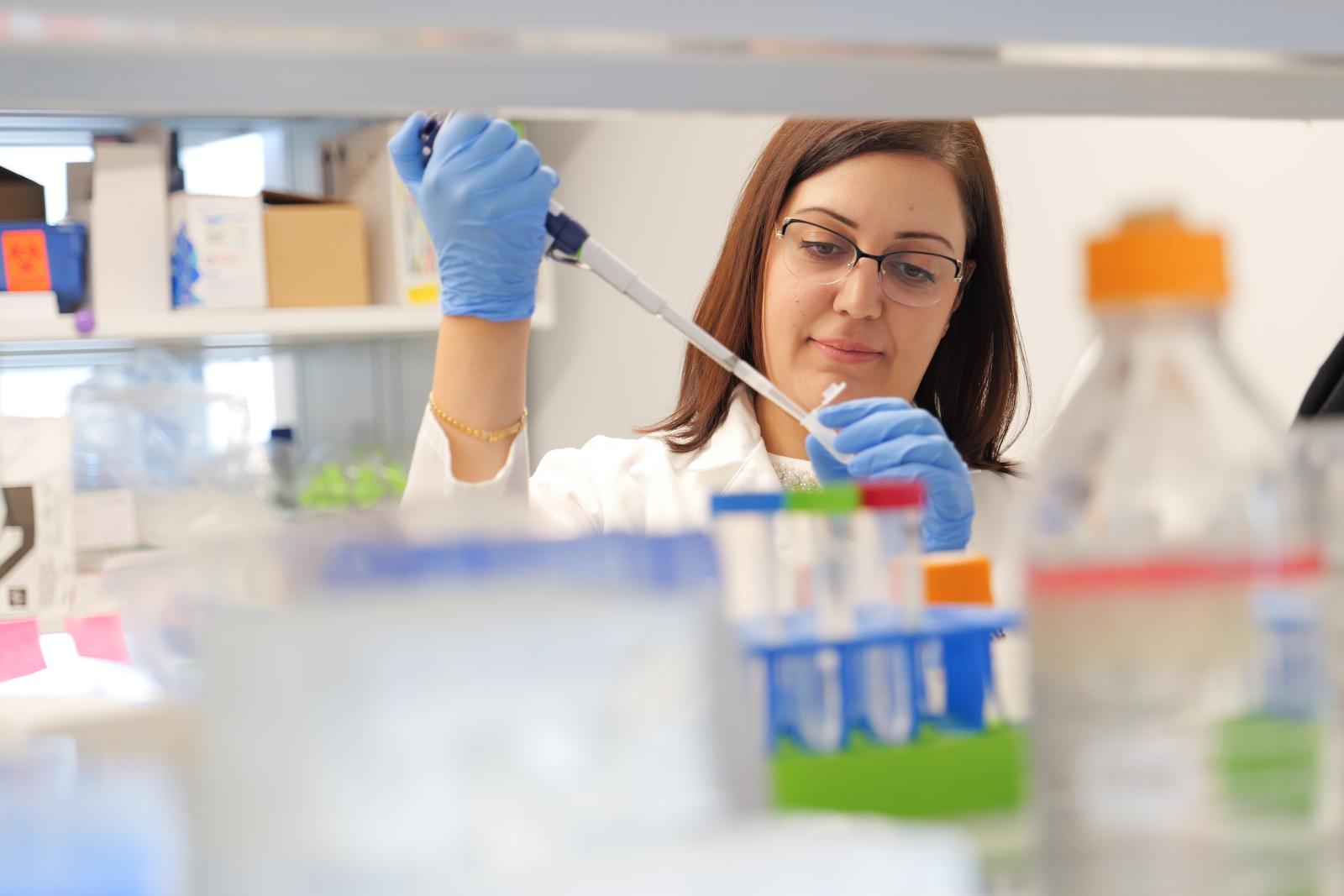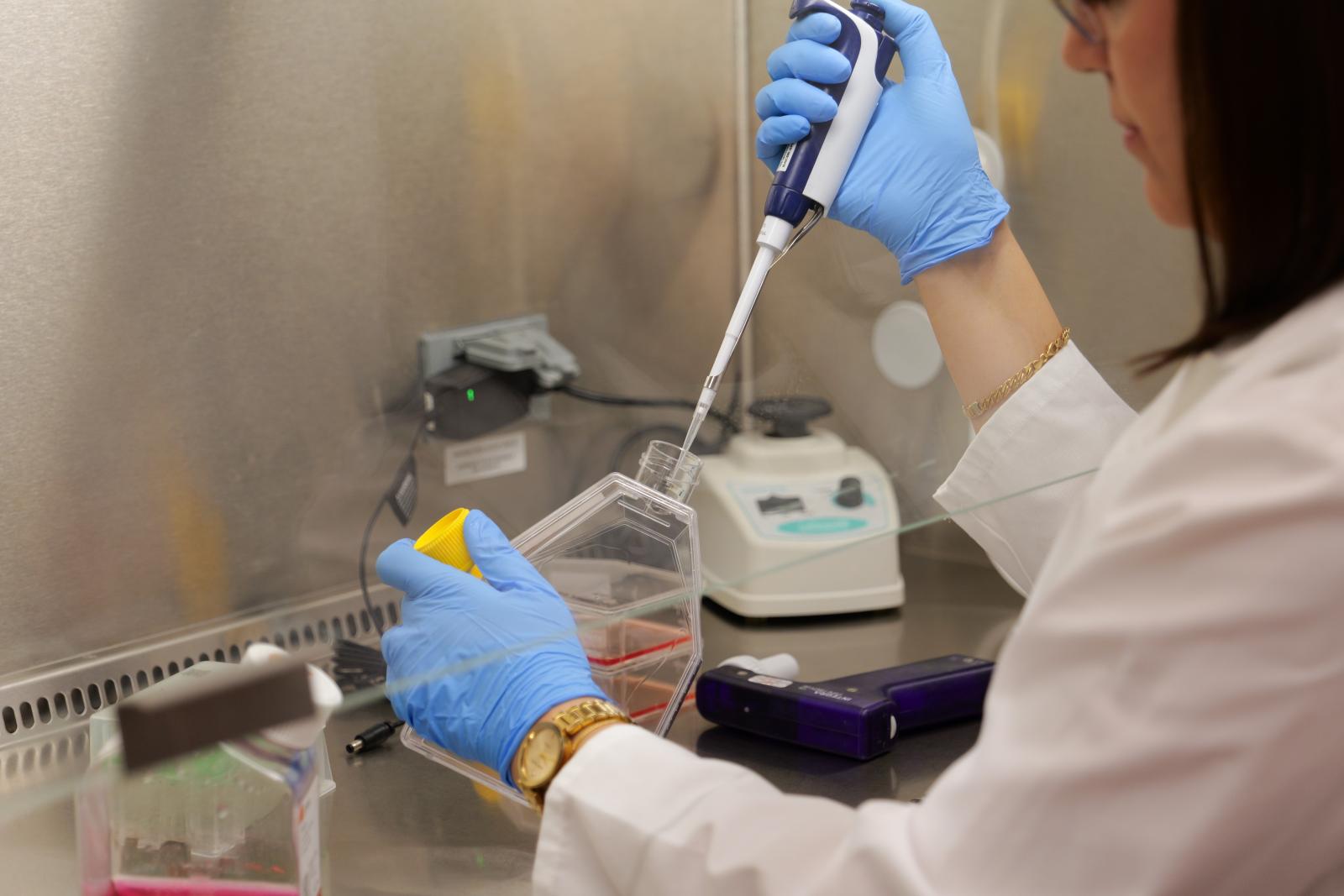Baker and Anabtawi characterize rare acute myeloid leukemia genetic mutation, offering a more personalized approach to patient therapy

Approximately 20,000 Americans are diagnosed with acute myeloid leukemia (AML) every year, according to the National Cancer Institute. This highly aggressive form of blood and bone marrow cancer is difficult to treat, in large part because of the wide range of genetic mutations that determine the molecular landscape and character of the disease.
Physicians in the Division of Hematology at The Ohio State University Comprehensive Cancer Center – Arthur G. James Cancer Hospital and Richard J. Solove Research Institute (OSUCCC – James) identified distinct occurrences of a rare point mutation (PM) in their AML patients: mutation in the FMS-like tyrosine kinase 3 (FLT3) gene juxtamembrane domain (JMD).
Care teams could see that these FLT3-JMD PMs were occurring but could not determine how this divergence in disease progression might affect their patients’ prognoses or treatment.
The oncology team at the OSUCCC – James connected with the Experimental Cancer Pharmacology Laboratory (ECPL) at the Ohio State College of Pharmacy for help.
A comprehensive effort
As the largest lab in the college’s Division of Pharmaceutics and Pharmacology, the ECPL focuses on collaborative research of cancer therapeutics and drug toxicity.
Nadeen Anabtawi, PharmD, a fifth-year PhD candidate, led the lab’s recent study of the FLT3-JMD PMs under the mentorship of Sharyn Baker, PharmD, PhD, ECPL co-principal investigator, professor and Gertrude Parker Heer Chair in Cancer Research at the college.

“Having access to resources from around the college and expert partners at the OSUCCC – James is what makes big projects like this possible. Great research cannot be done alone.”
Drs. Anabtawi and Baker sought to provide a comprehensive analysis of the mutating gene over the course of the study: “Prognostic, biological, and structural implications of FLT3-JMD point mutations in acute myeloid leukemia: an analysis of Alliance studies.” This project was supported by the Ohio State Comprehensive Cancer Center Pelotonia Foundation.
Professionals were recruited to join the research team from a variety of disciplines, with a final author list composed of pharmaceutical scientists, computational drug discovery researchers, oncologists and hematologists.
“Having access to resources from around the college and expert partners at the OSUCCC – James is what makes big projects like this possible,” Dr. Anabtawi said. “Great research cannot be done alone.”

The role of FLT3 in AML patient outcomes
The FLT3 gene is a key piece of the AML puzzle. Found mutated in approximately 30% of AML patients, it encodes an essential protein receptor for blood cell growth and has a central role in driving disease behavior. Dr. Anabtawi refers to it as the “engine switch.”
“The way that this gene mutates will determine whether the disease becomes more aggressive,” Dr. Anabtawi explained. “However, there isn’t one way that the gene mutates. In this study, we wanted to learn about a small subset of FLT3 mutations [FLT3-JMD PMs] that are becoming more frequently identified. Our goal was to better understand the patient outcomes from this mutation and begin to investigate what therapies and FLT3 inhibitors have the best chance to fight back.”
While extensive research has been conducted for the two most common FLT3 mutations, internal tandem duplications (ITD) and tyrosine kinase domain (TKD) PMs, the JMD PMs have gone largely uninvestigated due to the infrequency of their occurrence.
“Investigating rare mutations in diseases such as AML with FLT3-JMD point mutations presents significant challenges due to limited patient populations and incomplete biological information and outcomes data,” Dr. Baker said.
The mutation was identified in 2% of the study’s 1,660 patients.
The FLT3-JMD mutation weakens the part of the gene that acts as a “brake” for the FLT3 protein receptor. Without that membrane functioning normally, the receptor may send continuous growth signals, leading to proliferation of cancer-like blood stem cells.
Using patient data from the Alliance for Clinical Trials in Oncology, Dr. Anabtawi and the research team analyzed genomic profiles of AML patients to determine the frequency of FLT3-JMD PMs.
Utilizing the Hematology Tissue Bank Shared Resource (HTBSR), a biorepository at the OSUCCC – James, Dr. Anabtawi conducted high-throughput sequencing analysis of AML patients’ genomes to determine the rate of FLT3-JMD PM.
“Genomics profiling is routinely done in all patients with AML so we can know upfront if they have a mutation and can modify treatment protocols accordingly,” Dr. Baker said.
Analysis of the patients’ genetic sequencing allowed investigators to characterize the mutation and its effects on patients’ prognoses. In collaboration with the computational drug experts in the Cheng Lab at the College of Pharmacy, Dr. Anabtawi and the team also tested how different FLT3 inhibitors interacted with the mutation.
Through tests run by the Cheng Lab and cell survival assays conducted in the ECPL using cell lines and primary patient samples displaying FLT3-JMD PMs, a consistent pattern of increased sensitivity to an FLT3 inhibitor gilteritinib emerged.
Despite the mutation’s aggravation of AML expression, the resulting structural changes make the molecule more sensitive to treatment by gilteritnib.

How FLT3-JMD PMs insights define the future of AML treatment
While the study found those with the FLT3-JMD point mutation to have higher levels of relapse and lower overall survival rates than their peers without the mutation, it also found that the mutation displayed key similarities to the better-understood FLT3-ITD mutation found in AML patients.
An established FLT3 inhibitor was found to be quite effective based on the study’s findings of the mutation structure, suggesting a promising treatment for AML patients.
“Due to the rarity of this disease and mutation, it would be challenging to conduct randomized phase-III clinical trials,” Dr. Baker explained. “Our comprehensive laboratory mechanistic studies provided a strong rationale for treatment with FDA-approved FLT3 kinase inhibitors.”
While the small patient population means that further investigation is required to validate these results, identifying these connections and characteristics creates a foundation for the next wave of researchers.
“When we identify a specific genetic mutation that plays a role in patient outcomes, we can create a better treatment plan,” Dr. Anabtawi explained. “Screening for this gene mutation is now used in every patient who presents with AML. If we spot the mutation, we have an idea of what inhibitors will be more effective and what challenges the patient may face.”
Significantly, a lesser-known yet increasingly important subset of AML mutation has finally received concentrated attention.
“Throughout the years, clinicians and pharmacists have wondered why patients with the same diagnosis don’t react the same to treatment protocols,” Dr. Anabtawi said. “Now, thanks to advances in pharmacogenomics, we’re beginning to uncover those answers. Studies like this bring us closer to truly personalized medicine, improving both the quality and precision of care that patients receive.”